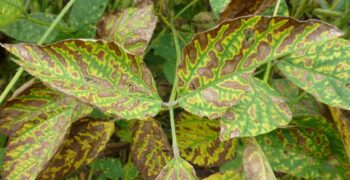Background:
Stink bugs are a group of insects known for their distinctive shield-shaped bodies and the foul odor they emit when disturbed. They are agricultural pests that can cause significant damage to a wide range of crops. There are two types of stink bugs: brown marmorated stink bugs and green stink bugs.
Brown marmorated stink bugs
Crops affected: Brown marmorated stink bugs are notorious for damaging a variety of crops but we’re most concerned about their damage to corn and soybeans.
Damage: They feed by piercing plant tissues with their mouthparts and sucking out plant juices. This feeding can cause deformities in fruits and vegetables, resulting in corky or necrotic areas that reduce marketability and yield.
Brown marmorated stink bugs
Crops affected: These species primarily affect crops such as cotton, soybeans and various fruits and vegetables.
Damage: Like brown marmorated stink bugs, they pierce plant tissues and suck out juices. This feeding can cause deformed or discolored fruit and reduce crop quality and yield.
Impact:
Stink bugs can be very damaging.
- Economic losses: Farmers can see significant economic loss due to reduced crop yields and decreased market value of damaged produce.
- Quality issues: Damage often results in cosmetic issues, making fruits and vegetables less appealing to consumers and reducing their marketability.
- Secondary damage: Stink bug feeding can open wounds on plants that may serve as entry points for pathogens, potentially leading to secondary infections and further crop damage.
Management and control:
Managing stink populations involves several strategies including the following:
- Monitoring: It’s essential to regularly scout and monitor fields to detect stink bug populations early and implement timely control measures.
- Cultural practices: Practices such as crop rotation and timely harvesting can help reduce stink bug populations by disrupting their life cycle and limiting their food sources.
- Chemical control: Insecticides are commonly used to manage stink bug populations during periods of high infestation. However, there are concerns about resistance development and environmental impact, so integrated pest management (IPM) approaches are recommended.



